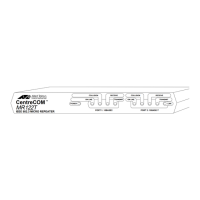Thick (10Base5) Ethernet
When configuring thick coax segments, IEEE 802.3 specifications allow 100
MAU attachments or less, spaced at multiples of 2.5 meters (8.2 ft.) measured
accurately from the cable end (50 Ω terminator included). The thick cable
segment cannot exceed 500 meters (1640 ft.) in length. Worst case "end-to-end"
propagation delay of a thick coax segment is 2165 ns. Propagation delay of thick
Ethernet coax is calculated at 4.33 es/meter. Both ends of the segment must be
terminated with a 50 Ω termination with a power rating of 0.5 watts or greater.
Earth grounding of the segment shield must take place at only one point on the
cable.
Propagation
Round-trip propagation delay throughout the entire cable system, from
farthest ends, may not exceed 51.7 µs.
Propagation delay is the time it takes a signal to travel from the input of a
system component to the output. Propagation delay is usually measured in
nanoseconds. IEEE 802.3 has specific propagation delay maximums for the
Ethernet components. Cable length plays a major role in propagation delay.
(i.e., a 50 meter [164 ft.] AUI cable has a maximum propagation delay of 257
ns.) The propagation delay of a cable is dependent on the length and velocity
factor of the cable type.
Four Repeater Rule
No more than four repeaters may be linked to connect five segments and no
other attachments may be on the linking segments. If attachments are present
on the repeater coax link segments, then no more than two repeaters linking
three segments may be configured. These limitations are set to keep
propagation delay, packet jitter, and signal attenuation to within acceptable
standards.
15
MR11x/MR12x.4Web Page 23 Monday, February 24, 1997 11:33 AM

